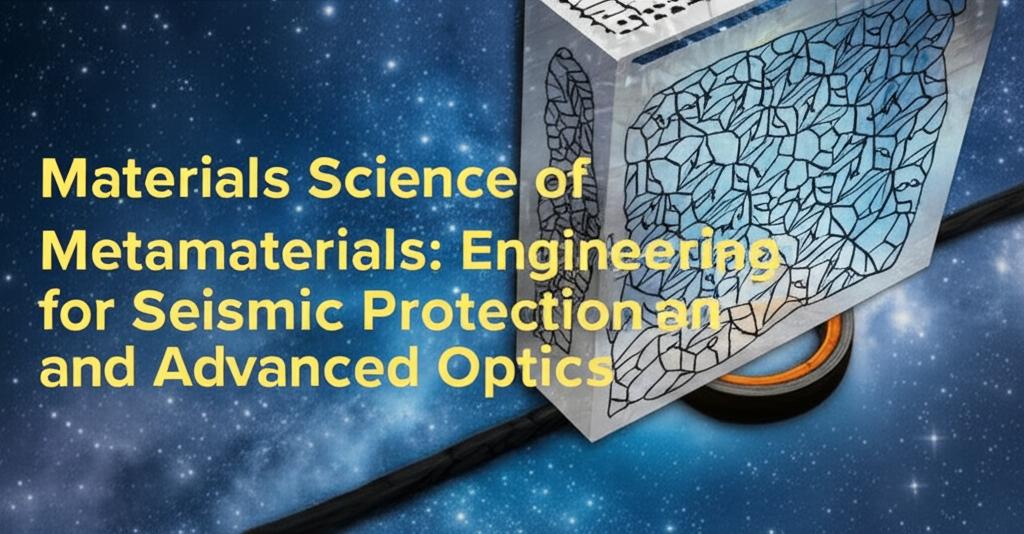Metamaterials, artificially engineered materials with properties not found in nature, are at the forefront of innovation in both seismic protection and advanced optics. Their unique ability to manipulate various types of waves, including seismic, acoustic, and electromagnetic waves, stems from their precisely designed internal structures rather than their chemical composition. Advances in computational design, 3D printing, and nanofabrication techniques have enabled the creation of metamaterials from a diverse range of base materials like metals, polymers, ceramics, and composites.
Seismic Protection:A significant area of metamaterial research is focused on mitigating the devastating effects of earthquakes. Seismic metamaterials are designed to interact with and control seismic waves, offering novel approaches to protect buildings and infrastructure. Key strategies include:
- Seismic Cloaking/Shielding: By carefully engineering their structure, metamaterials can steer seismic waves away from buildings, effectively "cloaking" them from the damaging energy. This can involve creating barriers that reflect or redirect the waves.
- Wave Attenuation and Filtering: Metamaterials can be designed to absorb or dampen the intensity of seismic waves, reducing their propagation through structures. This often involves creating "bandgaps," which are frequency ranges where the waves cannot pass through the material.
- Locally Resonant Metamaterials: This concept utilizes resonators embedded within a matrix material. These resonators can couple with seismic waves near their resonant frequencies, effectively plucking their energy and attenuating them. This approach is particularly promising for low-frequency seismic waves, as it allows for smaller and more practical structures compared to traditional Bragg scattering designs.
- Pillar-Type Resonators: Arrays of pillar-type resonators interconnected by thin bridges have shown promise in guiding surface waves (like Rayleigh waves, which cause significant earthquake damage) along programmed paths.
- Foundation Design: Research suggests that incorporating metamaterial principles into building foundations, such as using periodic arrangements of materials like steel and lead embedded in a rubber matrix, can significantly reduce vibrations experienced by the structure during an earthquake. Computer modeling has shown promising results for such metamaterial-based foundations.
While the investigation of metamaterials for seismic waves is a relatively new and complex field, ongoing research and successful demonstrations point towards their potential to revolutionize earthquake engineering. Earthquakes typically generate seismic waves within a narrow band of frequencies (0.01 Hz to 10 Hz), which may simplify the design of effective passive metamaterials. Some researchers are also exploring active metamaterials that can adapt their properties in real-time using smart materials responsive to electrical or magnetic inputs, though passive systems might be sufficient for many seismic applications.
Advanced Optics:In the realm of optics, metamaterials offer unprecedented control over light, leading to a host of groundbreaking applications:
- Negative Refractive Index: One of the most striking properties achievable with metamaterials is a negative refractive index, where light bends in the opposite direction to what is observed in natural materials. This opens doors for technologies like superlenses capable of imaging beyond the diffraction limit and potentially invisibility cloaks.
- Optical Modulation and Thermoresponsive Materials: Recent advances include fabrics that can alter the amount of light they absorb in response to temperature changes, using materials like graphene and shape memory polymers. These have potential applications in light therapy and vital sign detection.
- True One-Way Glass: Researchers have designed optical metamaterials that exploit the nonreciprocal magnetoelectric (NME) effect. This could lead to genuinely one-way glass that doesn't rely on differences in brightness, allowing light to pass in only one direction. Such a material could also improve solar cell efficiency by preventing thermal emissions from radiating back towards the sun.
- Metalenses: Metamaterials are enabling the creation of ultra-thin lenses (metalenses) that are a fraction of the thickness of conventional lenses while still offering precise control over light.
- AI-Driven Design: Artificial intelligence is increasingly being used to accelerate the design and discovery of optical metamaterials, allowing for rapid prediction of optical properties and the design of devices with specific functionalities.
- Enhanced Imaging: Metamaterials are being used to improve the signal-to-noise ratio in MRI machines, resulting in higher-resolution medical images.
- Improved Wireless Communications: Metamaterials embedded in antennas can enhance efficiency and bandwidth, particularly for 5G networks where mmWaves have limited range and are easily blocked. Reconfigurable Intelligent Surfaces (RIS) made from metamaterials can reflect and refract signals for better indoor reception.
- Atomic Arrays as an Alternative: Interestingly, recent research has demonstrated negative refraction of light using carefully arranged atomic arrays, bypassing some of the fabrication challenges associated with traditional metamaterials at optical frequencies. This approach leverages the cooperative interactions between atoms and offers a pathway to potentially lossless optical devices.
- New Material Platforms: Researchers are exploring alternatives to traditional noble metals (like gold and silver) for optical metamaterials, which can be costly and inefficient. Aluminum-doped zinc oxide (AZO) has emerged as a promising alternative, offering enhanced performance, compatibility with semiconductor manufacturing, and the ability to "tune" optical properties.
The field of metamaterials is rapidly evolving, with ongoing efforts to:
- Develop cost-effective and scalable manufacturing techniques.
- Ensure long-term durability and integration with existing construction and manufacturing methods.
- Explore multi-physics applications where metamaterials can control multiple types of energy simultaneously.
- Further integrate AI and machine learning for accelerated design and discovery.
Conferences and workshops, such as the International Workshop on Multiscale Innovative Materials and Structures (MIMS25) and the International Congress on Artificial Materials for Novel Wave Phenomena (Metamaterials 2025), continue to foster collaboration and showcase the latest advancements in this exciting and transformative field. From safeguarding our cities against earthquakes to revolutionizing how we interact with light, the materials science of metamaterials promises a future engineered with unprecedented control and functionality.

